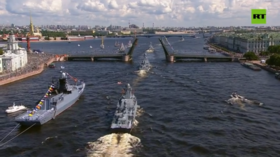Legendary Russian submarine designer dies

Igor Spassky, a renowned Soviet and Russian naval engineer, who is credited with over 200 completed submarine projects, has died at the age of 98.
The announcement was made on Tuesday by the administration of St. Petersburg, the city that awarded Spassky the title of honorary citizen in 2002 in recognition of his lifetime of achievements. Much of his professional career was spent at the Rubin design bureau, one of Russia’s three main facilities developing military and civilian submarines.
Governor Aleksandr Beglov hailed Spassky as a “legendary designer” and a rare person “whose knowledge and talent directed the development of an entire industry, determined its future and ensured the safety of our nation.”
Spassky was born in what is now the city of Noginsk in Moscow Region. In 1941, just as the Soviet Union was fending off the invasion of Nazi Germany, he joined a naval school in Moscow, before receiving a professional education as a military engineer.
In 1950, he was ordered to join what later became the Malakhit design bureau – another leading submarine maker – but three years later moved to Rubin, where he quickly rose to the position of deputy chief designer. From 1968 onwards, he was in charge of various major projects for the Soviet military.
Spassky oversaw the creation of several families of nuclear and diesel-electric submarines for the navy, including the Delta III-class (Kal’mar), the Delta IV-class (Delfin) and Typhoon-class (Akula) ballistic missile submarines, and the Oscar I-class (Granit) and Oscar II-class (Antey) cruise missile submarines.
The Kursk is arguably the most recognized of the Antey class submarines due to its tragic loss with all 118 crew on board in August 2000. Due to his expertise, Spassky was directly involved in attempts to rescue the sailors and officers. He later led an international effort to recover the wreckage of the Kursk from a depth of over 100 meters in the Barents Sea and transport it for scrapping.
Spassky also introduced oil rigs as a new specialty for Rubin. His highest-profile creation of this type was the Odyssey platform, the floating pad for the Sea Launch space project. It was designed to boost commercial cargoes into space from equatorial Pacific waters, where a minimum amount of fuel enables a craft to reach orbit. The last such launch took place in 2014.
Spassky also had a short-lived political career in the USSR as a city council member. He published over 100 papers on naval engineering and taught at the St. Petersburg State Marine Technical University.













